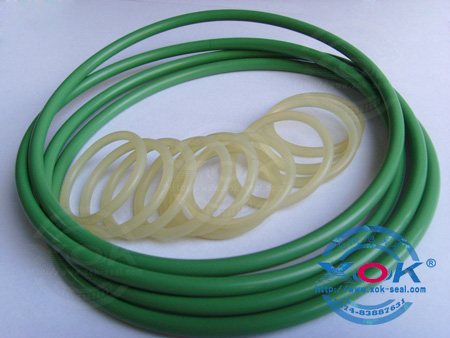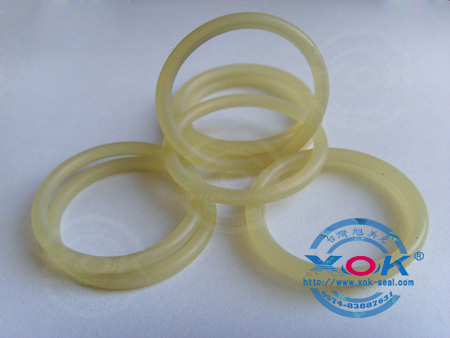I. Imported polyurethane O-ring PU
PU O-rings are also called polyurethane O-rings. They have high elasticity and strength, excellent wear resistance, oil resistance, hydrolysis resistance, fatigue resistance and vibration resistance. They are called "wear-resistant rubber". The polyurethane O-ring is produced by moulding process with no burr and small size error. All specifications and standards can be produced. Polyurethane O-ring is widely used in automobile parts, ship installations, aviation equipment, mining machinery, transportation, machinery and other industrial fields. Polyurethane rubber has good mechanical properties, high hardness, high elasticity and abrasion resistance, which are difficult to compare with other rubber. It also has good ageing resistance, ozone resistance and oil resistance.
Characteristics and advantages of polyurethane O-ring products:
Temperature range: - 40 ~+90 ~C
Colour: Black, green, orange, translucent, also can be specified by customers.
Hardness: Shaw hardness 70 +5 degrees
Standards: AS568, BS, P, V, G, BS, GB, M, non-standard
Advantages: Wear resistance, high pressure resistance, high temperature resistance
2. trimming of imported polyurethane O-ring PU
When rubber moulded products are vulcanized, excess rubber will flow out along the parting surface, forming different thickness of rubber edges. In order to make the product conform to the prescribed size and ensure the appearance quality, the cured product needs to be trimmed. Even if the product is pressed with an endless die, there will be a small amount of rubber edges. In O-ring products, these rubber edges are redundant. The process of removing these redundant rubber edges becomes trimming technically. The trimming methods of moulded rubber O-ring can be divided into two categories according to the operation mode: manual trimming and mechanical trimming.
In fact, rubber materials often do not embrittle when they reach glass transition temperature. In order to ensure trimming smoothly, the freezing temperature is usually about 10 degrees lower than the brittleness temperature of the compound. The choice of refrigeration method is mainly based on refrigeration effect and cost. Most rubber becomes brittle at - 20 - 150 C. Generally used refrigeration methods are: refrigeration with Freon as refrigerant, refrigeration temperature is 0-120 degrees C; solid or liquid carbon dioxide refrigeration, refrigeration temperature is 0-79 degrees C; in contrast, refrigeration energy consumption and investment of refrigeration machine is large, cost is high, carbon dioxide refrigeration equipment is simple, low price, but when used, liquid carbon dioxide sometimes frost phenomenon, solid carbon dioxide refrigeration temperature. The degree is difficult to adjust. At present, liquid nitrogen refrigeration is widely used abroad.
III. Inspection of Imported O-ring PU Products
1. Appearance quality inspection
The appearance of O-ring is visualized. Generally, no pore, crack, impurity and bubble are allowed in O-ring. The surface of O-ring should be smooth and clean. Surface defect types and quality requirements shall not exceed the limits specified in the national standard GB3452.2-2007, and shall be classified into N, S and CS levels according to the requirements for appearance quality in use. Class N stipulates the criteria for inspection and determination of O-rings for general use, and Class S stipulates the criteria for inspection and determination of O-rings for higher appearance quality level or higher tolerance accuracy of surface defect size. This level includes applications in aerospace, important industries or automotive industries. CS level specifies the criteria for O-ring inspection and judgment, which is used for high level of appearance quality or high accuracy of surface defect dimension tolerance. This level covers some key applications in aerospace or pharmaceutical industries. In these cases, in order to achieve the first satisfactory results, the surface stress of O-ring should be free of defects.
2. Size Inspection
The O-type rubber sealing ring can be measured according to the specific requirements of its cross-section, internal and external diameter. According to the size of specifications, vernier calipers, rulers or tapes with the required accuracy, as well as optical instruments such as mobile microscope and projection microscope, can be used to measure. Dimensions and tolerances shall conform to the size specified in national standards or corresponding requirements.
1. Inspection of physical and mechanical properties of finished products
The physical properties of O-type rubber seals can also be tested according to different requirements. Hardness, tensile properties, long-term compression deformation, hot air aging, compression stress relaxation, liquid resistance and density test of solid O-type rubber seals can be tested according to GB/T5720-2008 standard.
IV. Requirements for Formulation Design of Imported O-ring
Imported O-ring, which plays a sealing role in various mechanical equipment, generally requires that its compound must have good elasticity or low compression and long-term deformation and aging resistance. In addition, different mechanical equipment and different sealing media require that the compound should also have some special properties. In hydraulic system, O-ring compound is required to have good oil resistance, temperature resistance, low long-term compression deformation and certain tensile strength. As a dynamic seal, besides the above requirements, the wear resistance and tear resistance of the compound should also be considered. Seals used in vacuum environment require good air tightness and volatility. Seals used in special media require little change in volume and hardness of the compound in the medium, and little change in other properties. In conclusion, the formulation design should be considered comprehensively according to the specific working conditions, medium types, service temperature, working pressure and application status. From the technical requirements and application of O-ring, the rubber consumption of NBR is larger, followed by fluorine rubber, terrestrial butadiene rubber and silicone rubber, and propionate rubber and ethylene propylene rubber are relatively small.





